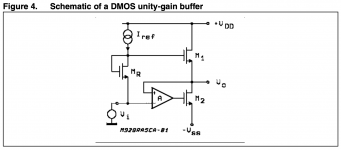Hi all,
I came across the TDA7293 output stage in another thread, I think it could make for an interesting discrete design for a very low distortion unity gain buffer.
The reason I think it has value as a discrete solution:
- Uses all N type MOSFETs (could use BJTs as well I guess) so we have more options.
- Simple.
- Low distortion due to the op amp.
Draw backs:
- The op amp could make global feedback networks difficult.
- The op amp supply constrains the voltage swing and thus power of the output stage.
The datasheet is here.
The output stage is attached to this post.
The only thing is I struggle to understand how it works in class AB or with an output load.
If we assume there is a speaker attached and M1 is partially biased for class AB how will it ever source more current than the quiescent bias current. Essentially, the output stage needs to operate in class A. The output will maintain Vo = Vi so M1s Vgs can only ever be the bias generated by Mr. Does this design only work as it's implemented on the same die? It's quite easy to rearrange the circuit into something else but it loses some simplicity and loses the extra gain offered by M2 in the common emitter config.
Any insights are appreciated!
I came across the TDA7293 output stage in another thread, I think it could make for an interesting discrete design for a very low distortion unity gain buffer.
The reason I think it has value as a discrete solution:
- Uses all N type MOSFETs (could use BJTs as well I guess) so we have more options.
- Simple.
- Low distortion due to the op amp.
Draw backs:
- The op amp could make global feedback networks difficult.
- The op amp supply constrains the voltage swing and thus power of the output stage.
The datasheet is here.
The output stage is attached to this post.
The only thing is I struggle to understand how it works in class AB or with an output load.
If we assume there is a speaker attached and M1 is partially biased for class AB how will it ever source more current than the quiescent bias current. Essentially, the output stage needs to operate in class A. The output will maintain Vo = Vi so M1s Vgs can only ever be the bias generated by Mr. Does this design only work as it's implemented on the same die? It's quite easy to rearrange the circuit into something else but it loses some simplicity and loses the extra gain offered by M2 in the common emitter config.
Any insights are appreciated!
Attachments
Last edited:
